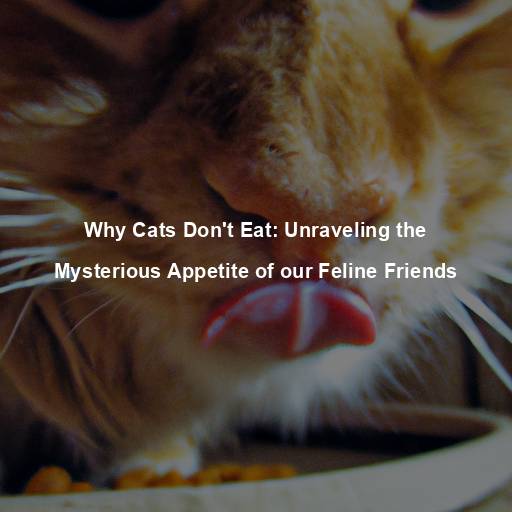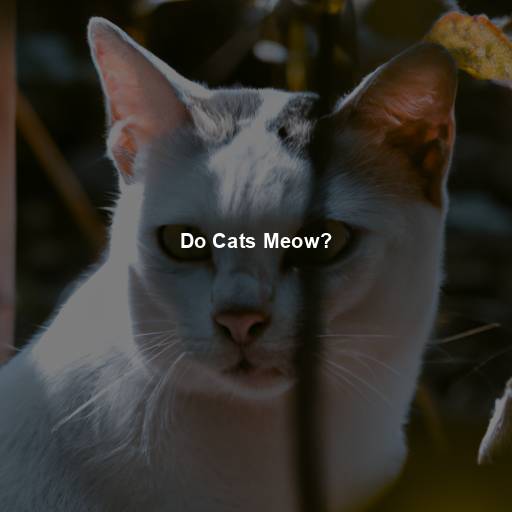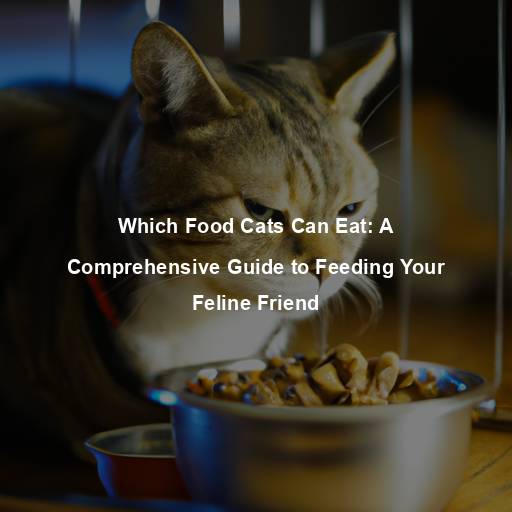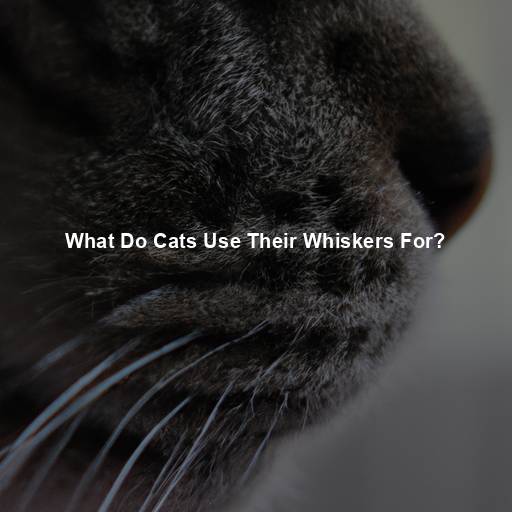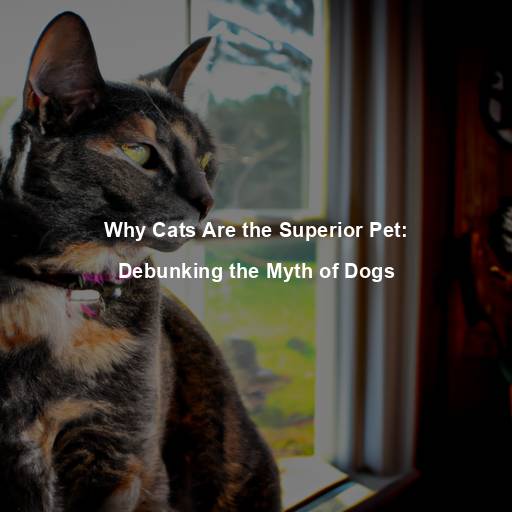Why Cats Don’t Eat: Unraveling the Mysterious Appetite of our Feline Friends
Last Updated on November 21, 2023 by Evan
Contents
- 1 Understanding the Picky Eaters
- 2 Unveiling the Secrets
- 3 Embracing the Journey: Nurturing a Healthy Appetite
- 3.1 Nutritional Considerations: Finding the Right Balance
- 3.2 Gradual Transition: Introducing New Foods
- 3.3 The Power of Rewards: Positive Reinforcement
- 3.4 Environmental Enrichment: Mealtime Engagement
- 3.5 Homemade Diets: Proceed with Caution
- 3.6 Monitoring Food Intake: Weight Management
- 3.7 Seeking Veterinary Guidance: Professional Advice
- 4 FAQs: Why Cats Don’t Eat
Understanding the Picky Eaters
Cats are often regarded as finicky eaters, known for their selective preferences when it comes to food. Have you ever wondered why your beloved feline companion turns their nose up at certain meals? In this exploration, we delve into the fascinating world of a cat’s appetite, unraveling the reasons behind their picky eating habits. Let’s discover the mysteries that lie behind those discerning taste buds!
The Evolutionary Palate
Cats have an intriguing past as carnivorous creatures, linked to their lineage of independent hunters. In the depths of the wild, their hunger is appeased by a feast of petite creatures like birds and rodents, which nourish them with vital nutrients. Over time, this ancestral legacy has influenced their culinary inclinations, enticing them towards a preference for meaty delicacies. The aromatic allure, tantalizing taste, and delectable texture of their prey effortlessly contribute to their contentment and holistic health.
Sense of Smell: A Whisker Above
A cat’s sense of smell is far more superior to ours, with approximately 200 million scent receptors compared to our mere 5 million. This heightened olfactory ability enables them to detect minute differences in odors, making them extremely sensitive to the scent of their food. If a particular aroma doesn’t appeal to them, they may reject it outright, regardless of its nutritional value.
Texture Matters
Cats, enigmatic creatures that they are, possess a fascinating array of culinary eccentricities when it comes to the texture of their meals. It’s a cat’s world, and we’re just living in it, as some felines audaciously strut their stuff in the wet food aisle, while others confidently prowl towards the dry kibble section. Delving deeper into this puzzling feline phenomenon, we discover that an assortment of factors play a role in their gastronomic proclivities. From dental health and personal taste to even the whimsical influence of the weather, the enigmatic preferences of our feline friends take center stage.
The Power of Presentation
It may come as a surprise, but cats actually care about how their food is presented to them. These curious creatures are notorious for paying attention to the smallest details, and the visual aspect of their meals is no exception. The color, shape, and overall appeal of their food can greatly influence their appetite and enjoyment. By making sure their meals are visually stimulating, you can encourage your cat to eagerly embrace their mealtime and devour their food with excitement.
Environmental Factors
Similar to how people can be affected by their environment and external circumstances, cats are also susceptible to these influences. Factors such as stress, anxiety, alterations in their daily routines, or introducing them to unfamiliar surroundings can significantly impact their appetite. To promote a healthy eating habit, it is crucial to establish a serene and comfortable environment that provides cats with a tranquil space to eat, free from any forms of distractions or disturbances. By removing potential stressors, cat owners can effectively encourage their feline friends to maintain a well-balanced diet.
The Need for Variety
As feline aficionados, we know that our furry friends have discerning palates that crave excitement and diversity. Mere repetition in their meals can lead to discontentment, and that’s where the magic of variety comes in. By introducing an array of tantalizing flavors, textures, and protein sources, we can successfully captivate their taste buds and keep them engaged. However, we must exercise caution in our culinary ventures, as a sudden change in diet might stir up digestive disturbances.
Health Concerns and Dietary Restrictions
In some cases, a cat’s refusal to eat may be an indication of an underlying health issue. Dental problems, gastrointestinal disorders, or even allergies can affect their appetite. If your cat consistently displays a lack of interest in food or experiences sudden changes in eating habits, it’s crucial to consult a veterinarian. They can thoroughly examine your cat and provide guidance on potential health concerns or dietary restrictions.
The Art of Patience
Understanding and accommodating a cat’s picky eating habits requires patience and perseverance. It’s important not to force-feed or resort to unhealthy habits, such as offering excessive treats. Instead, focus on providing a balanced diet, tailored to their specific needs, while respecting their individual preferences. Building a trusting relationship and creating a positive mealtime experience can help cultivate a healthy eating routine for your feline companion.
Unveiling the Secrets
Unraveling the enigmatic world of a cat’s discerning palate reveals a tapestry of complexities. An amalgamation of evolutionary ancestral instincts, finely tuned senses, external surroundings, and potential health intricacies intertwine to shape their individual culinary proclivities. Amidst this intriguing puzzle, lies the opportunity to deepen our connection with these graceful creatures and safeguard their nutritional harmony.
The enigmatic ways in which our feline friends approach their meals never cease to perplex us. Each whiskered wonder seems to possess an unparalleled sense of individuality, reflected prominently in their discerning taste buds. Rather than being discouraged by their finicky nature, let us embrace the journey of fulfilling their distinct culinary cravings as an opportunity to strengthen the bond we share. For it is within the mysterious realm of untapped feline appetites that the secrets lie – a treasure trove of diverse factors that contribute to their selective dining habits.
Sensory Sensitivities: Taste and Smell
As any cat owner knows, our feline friends possess a curious relationship with taste. Though their taste buds may be fewer in number compared to our own, their discerning preferences are a fascinating blend of flavors and scents. Cats, being the carnivores that they are, exhibit a reduced inclination towards sweetness, gravitating instead towards the savory and meaty delights that align with their evolutionary needs. It’s not just the taste that matters to them, but also the enticing aroma that plays a crucial role in determining the delectability of their meals, relying on their keen sense of smell to guide their culinary choices.
Socialization and Learned Behavior
Cats are observant creatures and can learn from their environment and interactions with other cats or humans. For example, if a cat observes their feline companion or human family member displaying a preference for certain foods, they may mirror this behavior and develop similar preferences. This learned behavior can contribute to their selective eating habits and the formation of their personal palate.
The Role of Texture: Crunchy vs. Moist
In addition to taste and smell, the texture of food plays a significant role in a cat’s eating experience. Some cats prefer the crunchiness of dry kibble, which can help maintain dental health and satisfy their natural inclination to chew. On the other hand, moist or wet food can provide hydration and may be easier to eat for cats with dental issues or older cats. Understanding your cat’s texture preferences can help you choose the right type of food that they will enjoy and benefit from.
Age-Related Changes
As our feline friends journey through the passage of time, their appetites and dietary demands tend to undergo a bewitching transformation. During the early stages of their lives, those adorable balls of fur known as kittens demand a distinct cocktail of nutrients that sets them apart from their seasoned adult and senior counterparts. It becomes paramount for us to navigate this perplexing landscape and tailor their nourishment to cater to their evolving needs as they rejuvenate their bodies. Meanwhile, our wizened senior cats may yearn for a softer, gentler fare that dances effortlessly through their digestive systems, while the ambitious kittens forge their path with specific formulas designed to nurture their rapid growth and enchanting development.
Stress and Anxiety: Appetite Suppressants
The hidden link between a feline’s emotional state and their appetite is more intricate than one might think. Those furry friends of ours can be deeply affected by stressful situations, be it a change in their surroundings or the sudden appearance of new companions. Consequently, their once hearty appetite may suffer a decline. This is largely due to their preference for a consistent routine, as even the slightest disturbance can throw their eating habits out of whack.
Medical Conditions: Underlying Health Issues
In some cases, a cat’s refusal to eat or their selective eating habits can be a sign of an underlying health issue. Dental problems, gastrointestinal disorders, or even allergies can affect their appetite and cause discomfort during mealtime. Regular veterinary check-ups are essential to identify any potential health concerns and address them promptly. Your veterinarian can provide guidance on the appropriate diet and any necessary modifications to ensure your cat’s overall well-being.
The Importance of Feeding Routines
Establishing a consistent feeding routine is crucial for cats. Cats are creatures of habit and thrive on predictability. Irregular feeding patterns or free-feeding practices can disrupt their natural instincts and lead to picky eating habits. Providing meals at regular intervals and removing any uneaten food after a designated period can help encourage a healthy appetite and prevent overeating.
Embracing the Journey: Nurturing a Healthy Appetite
Understanding the multifaceted nature of a cat’s eating habits allows us to approach their nutritional needs with empathy and adaptability. By considering their sensory sensitivities, individual preferences, and the various factors that influence their appetite, we can provide a well-rounded diet that satisfies both their nutritional requirements and their unique palate.
As cat owners, we must never forget that each feline is a unique and enigmatic creature, with their own idiosyncrasies and desires. It is a fascinating and oftentimes befuddling adventure to unlock the secrets of their palate and ensure their nutritional satisfaction. Be prepared for a wild ride as you navigate the mysterious world of cat cuisine, armed with patience, keen observation, and a willingness to adapt. Remember to consult with your trusted veterinarian for guidance along the way, and relish in the profound bond that unfolds as you uncover the intricate tapestry of your cat’s culinary preferences.
In the end, the mysterious reasons behind why cats don’t eat are as diverse as the cats themselves. It is through our commitment to understanding, compassion, and attentive care that we can ensure our feline friends lead happy, healthy, and gastronomically satisfying lives. ## Unveiling the Secrets: A Deeper Dive
Nutritional Considerations: Finding the Right Balance
It’s essential to provide a balanced and nutritious diet for our feline companions. While cats require specific nutrients such as taurine, arachidonic acid, and vitamin A, they also need a proper balance of proteins, fats, and carbohydrates. Commercial cat foods are formulated to meet these nutritional requirements, ensuring that your cat receives the necessary nutrients for optimal health. However, consulting with your veterinarian can help you determine the best diet plan based on your cat’s specific needs and any underlying health conditions.
Gradual Transition: Introducing New Foods
When it comes to trying out new delicacies for your beloved feline friend, it’s best to tread with caution and avoid any tummy troubles. Begin by fusing small portions of the innovative fare with their regular diet, and gradually amplify the amount of the new food as days go by. This methodical approach gives your cat’s belly the chance to acclimate to fresh sensations and flavors, minimizing the chances of them turning their nose up or experiencing any digestive distress. Remember, Rome wasn’t built in a day, so be patient and give your furry companion the space they need to truly savor the novelty of their nourishment.
The Power of Rewards: Positive Reinforcement
When it comes to enticing your feline friend to broaden their culinary horizons or tackle their selective eating tendencies, embracing positive reinforcement techniques can work wonders. By tantalizing their taste buds with delectable morsels or showering them with praise when they exhibit curiosity towards a specific dish, you can establish a delightful connection that motivates them to embark on a flavor-filled adventure. Nevertheless, it’s crucial to exercise caution when dishing out treats, ensuring that they maintain a balanced nutritional profile to dodge the pitfalls of overindulgence or an unbalanced diet.
Environmental Enrichment: Mealtime Engagement
Transforming your cat’s mealtime into a fascinating and captivating affair could revolutionize their enthusiasm for food. Think outside the bowl and introduce interactive feeding toys or puzzles that tease their brains and challenge their instincts. By incorporating these ingenious toys into their dining routine, you can awaken their innate hunting abilities and turn each meal into an exhilarating adventure. Rousing their minds and bodies through interactive feeding not only ensures a healthy appetite, but also promotes their overall contentment and vitality.
Homemade Diets: Proceed with Caution
Have you ever pondered the idea of concocting a homemade feast for your feline friends? It’s no secret that some pet owners toy with the idea, whether it’s to appease their finicky taste buds or embrace a more au naturel approach. However, before you dive headfirst into the world of homemade diets, let’s navigate the labyrinthine path together. Customizing the menu to cater to your beloved cat’s unique nutritional needs sounds divine, but with great power comes great responsibility – consulting a veterinary nutritionist is of the utmost importance.
Monitoring Food Intake: Weight Management
Maintaining a healthy weight is essential for your cat’s overall health and well-being. While some cats may be picky eaters and refuse certain foods, it’s important to ensure they are consuming enough calories to meet their energy requirements. Regularly monitoring your cat’s food intake and body condition can help you identify any changes in appetite or weight. If you notice significant changes, consult with your veterinarian to rule out any underlying health issues and develop a suitable weight management plan.
Seeking Veterinary Guidance: Professional Advice
If your cat’s picky eating habits persist or are accompanied by other concerning symptoms, it’s crucial to seek veterinary advice promptly. A veterinarian can perform a thorough examination, conduct diagnostic tests if necessary, and provide guidance tailored to your cat’s specific needs. They can help identify any underlying health issues, address nutritional concerns, and recommend appropriate dietary modifications or supplements.
FAQs: Why Cats Don’t Eat
Why is my cat not eating?
When it comes to feline dining dilemmas, the reasons behind your cat’s lack of appetite can be as varied and perplexing as a Rubik’s Cube. From health issues lurking in the shadows to the finicky taste buds of your feline companion, there are numerous factors that could be casting a shadow over their mealtime joy. Could it be an underlying illness or injury playing hide-and-seek with their hunger? Or perhaps the culprit is the ever-changing landscape of their routine, environment, or even the menu du jour. And let’s not discount the influence of stress, anxiety, or those pesky dental problems, which can all conspire to leave your cat’s food bowl untouched. If your precious ball of fur hasn’t partaken in a feast for more than a day or two, it’s time to wave the flag of puzzlement and seek the wisdom of a veterinarian, who can untangle this culinary conundrum with their expertise and offer the purrfect diagnosis and guidance.
What should I do if my cat refuses to eat?
As pet parents, we often face moments of confusion and concern when our feline friends suddenly lose their appetite. It can be quite perplexing to see them turn away from their meals, leaving us with a sense of uncertainty. To address this burst of doubt, it’s important to closely observe your cat’s behavior and overall well-being. Creating a serene and undisturbed environment for their mealtime, along with fresh food and water, might just do the trick. In some cases, experimenting with different types of food or incorporating wet food into their diet could spark their interest. To make things even more tantalizing, consider warming up their food slightly or offering them small, frequent meals throughout the day instead of larger portions. However, if your cherished feline companion continues to reject food for more than 24 hours or exhibits signs of illness, it’s paramount to seek professional assistance from a veterinarian who can unravel the mysterious puzzle and provide the guidance needed.
Is it normal for a cat to lose its appetite?
A temporary loss of appetite in cats can be quite common and often resolves on its own. Factors such as stress, changes in the environment, or minor illnesses can contribute to a decreased appetite. However, if the loss of appetite persists for more than a couple of days, it may indicate an underlying health issue. Cats are generally known for their strong survival instincts, and a prolonged lack of interest in food can be a sign of a serious problem. Thus, it is best to consult with a veterinarian if your cat’s appetite doesn’t improve.
How can I stimulate my cat’s appetite?
To stimulate your cat’s appetite, you can try a few different approaches. Firstly, ensure the food you offer is fresh, high-quality, and appealing to your cat’s taste. Warming the food slightly can enhance its aroma and make it more enticing. Some cats may prefer wet food over dry kibble, so experimenting with different textures can be helpful. Engaging in playtime before meals can also stimulate their appetite. If all else fails, speak to your vet who may recommend appetite-stimulating medications or offer further advice tailored to your specific situation.
Can stress affect a cat’s eating habits?
Absolutely! Cats can be quite sensitive to stress, which can have a direct impact on their eating habits. Any shifts in their environment, routine, or the addition of new pets or people can cause them to feel overwhelmed and anxious, leading to a decrease in their appetite or even a complete loss of interest in food. It’s crucial to create a soothing and stable atmosphere for your feline friend, complete with safe hiding spots and engaging activities like playtime or grooming sessions, to help alleviate their stress and encourage them to eat. If the stress persists or worsens, seeking guidance from a veterinarian to explore additional strategies for managing stress could be highly beneficial.

